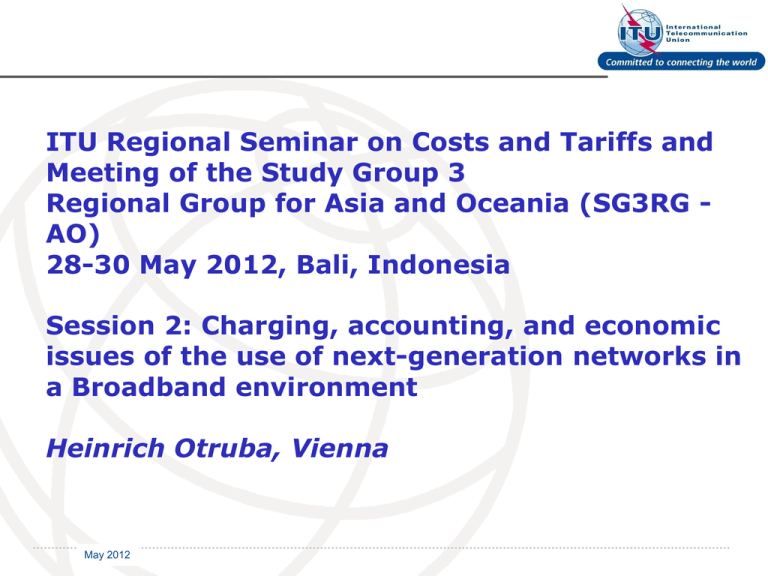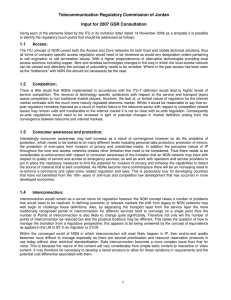ITU Regional Seminar on Costs and Tariffs and
advertisement

ITU Regional Seminar on Costs and Tariffs and Meeting of the Study Group 3 Regional Group for Asia and Oceania (SG3RG AO) 28-30 May 2012, Bali, Indonesia Session 2: Charging, accounting, and economic issues of the use of next-generation networks in a Broadband environment Heinrich Otruba, Vienna May 2012 International Telecommunication Union Agenda NGN – NGA Definitions NGN Basic structure and issues IP Interconnection Service, transport layer PoI Charging systems Qos Cost Accounting and Cost models NGN – NGA Agenda Definitions NGN Basic structure and issues IP Interconnection Service, transport layer PoI Charging systems Qos Cost Accounting and Cost models NGN Definition Next Generation Network (NGN): • • • a packet-based network able to provide telecommunication services and able to make use of multiple broadband, QoS-enabled transport technologies and in which service-related functions are independent from underlying transport-related technologies. It enables unfettered access for users to networks and to competing service providers and/or services of their choice. It supports generalized mobility which will allow consistent and ubiquitous provision of services to users. •(ITU-T Recommendation Y.2001) NGA NGA: Fibre based very high speed access networks Allow to provide high speed broadband communication services with speeds up 100mbit/sec Two major technologies in the market: FTTH, FTTN plus VDSL for the last 100m, FTTH: PP and PON architectures rolled out CATV: DOCSIS 3.x Focus of this presentation NGN Agenda NGN – NGA Definitions NGN Basic structure and issues IP Interconnection Service, transport layer PoI Charging systems Qos Cost Accounting and Cost models NGN Basic Structure As an economist, my technical knowledge is - by nature - rather limited, I leave technical explanations to engineers and concentrate on some generic issues, which surfaced in the discussions of the last years. From the regulatory point of view the separation of transport oriented technologies from service oriented functions in a packet oriented network seems crucial for the discussion of regulatory, economic, cost aspects of the transition to NGNs Primary effects are seen in flatter network hierarchy and „simpler“ network architecture From PSTN to NGN Source: BT Chae-Sub, LEE - Chairman of FG NGN - NGN Technical Workshop 14 ~ 15 March 2005, Jeju, Korea Service domain NGN Basic Issues As a consequence of the basic properties of NGNs IP interconnection assurance of Quality of service; implied cost savings by different network topology •seem to be the crucial issues attributed to NGNs, at least from an economic perspective • NGN – NGA Contents • Definitions NGN Basic structure and issues IP Interconnection Service, transport layer PoI Charging systems Qos Cost Accounting and Cost models IP-Interconnection IP Interconnection describes interconnection services between IP based networks and in particular NGNs. IP-Interconnection will have two layers: service interconnection and transport interconnection, Both layers may in practice be bundled as traditionally in interconnection between PSTN networks: Transport-service interconnection (TISPAN/ETSI Service oriented interconnection) IP-Interconnection In practice services tend to be provided using centralized platforms (Media Gateway, Softswitch). Operators, who have market power may not have an incentive to open their networks to competition at the service level and may want to limit use of these capabilities. This impacts on the ability of independent service providers to integrate their services into the NGN platform. Regulatory intervention may be required Furthermore, such a configuration of services and the centralization of the control function have implications for the locations at which traffic can be handed over to other networks or received from other networks. This feature will therefore be crucial for the possibility of defining number and location of interconnection points in NGNs. Core elements of IP Interconnection Core elements of interconnection: number and geographic location of interconnection points as well as functionality and hierarchy of these interconnection points, determined by the network architecture network performance needs to be specified e.g. best effort and/or some additional transport classes specifying the relevant network performance parameters like jitter, delay and packet loss; charging mechanism used, i.e. who pays for which part of the value chain. This has an impact on the market power that can be exerted by different market parties at different levels of the value chain in case interconnection is regulated according to ex-ante cost based regulation, costing and pricing principles have to be discussed (structure of tariffs according to hierarchy, accounting units such as minutes, bandwidth, etc.) Differences to PSTN and implications Fewer interconnection points (PoP): in particular for service interconnection the number of PoPs will drop significantly, for transport interconnection similar. Lower initial investments due to smaller number of PoI Hierarchy of NGNs flatter, only two layers: Metropolitan, Top Layer Fewer PoI Stranded investments in PSTN-PoI, which are no longer needed/available QoS, Charging system In classical PSTN the network performance in relation to interconnection services was implicitly defined by technology (64kb channels) In NGNs service quality for voice services and Internet etc may be different and must be specified. In PSTN local access combined with control over IP addresses and/or E164 numbers and the Calling Parties Network Pays Principle creates a „bottleneck“ situation, which gives rise to potential abuse of market power and regulation. In IP networks other charging systems are the rule: BaK, Transit fees. A change of the interconnection regime for voice services is under consideration in the EU. Interconnection Systems and NGNs PSTN: access monopoly, control over E.164 numbers and CPNP principle create a necessity for regulation of interconnection fees Question: are there other options? BaK generally used for IP interconnection Why not BaK for voice interconnection between NGNs? BaK for voice interconnection between NGNs Pro: Same system as used for IP interconnection Simpler and cost efficient: no detailed measuring of traffic, no billing, no regulatory disputes Strong incentive for network efficiency if calling party is not compensating costs of the terminating network Contra: Introduction costs Asymmetric traffic? Hot potato routing? Competitive access markets precondition • NGN – NGA Contents • Definitions NGN Basic structure and issues IP Interconnection Service transport layer PoI Charging systems Qos Cost Accounting and Cost models Quality of Services NGN architecture allows to specify different QoS for different services E.g. Internet: best effort, voice and video services (real time services) high QoS. Far reaching consequences for architecture and costs QoS specified in terms of reliability, availibility and relevant network performance parameters like jitter, delay and packet loss. Problem: possible degradation of „best effort“ to lure end users into higher service qualities at higher prices, sometimes discussed as a major aspect of „Net Neutrality“ NGN – NGA Contents Definitions NGN Basic structure and issues IP Interconnection Service transport layer PoI Charging systems Qos Cost Accounting and Cost models Cost structure, cost models Flatter hierarchy, economies of scope and different types and numbers of network elements imply significantly different cost levels significantly different cost structure Newly developed cost models for regulatory purposes necessary Cost models for NGNs 1 Generic structure of regulatory cost models preserved Computer model for efficient network structure (“bottom up”) Cost accounting rules: But: current cost accounting economic depreciation (if possible) Cost of capital calculations with risk adjustment (“WACC”) Cost allocation using „routing tables“, Other network elements as implied by different architecture No general agreement on “optimal” network Significantly higher share of joint and common costs due to economies of scope of “all IP” approach Allocation via quantity-cost relations restricted, i.e. routing tables will not be able to allocate all joint costs to services Consequence: Slopes of Q-C relations flat, high shares of fixed costs, very low incremental costs Cost models for NGNs 2 Several different models in the market Developed by different consultancies e.g. WIK Analysys-Mason Deloitte Consulting others… Have slightly different approaches according to different customer profiles No standardization of model philosophies Thank you very much for your questions, comments and ideas • Yes, you can reach me: • Email: hoirac@me.com • Phone: +43 6509602141
